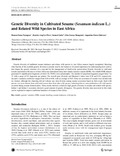Genetic Diversity in Cultivated Sesame (Sesamum indicum L.) and Related Wild Species in East Africa
Date
2015-08-21Author
Gudu, Samuel
Otto George Dangasuk
Beatrice Ang’iyo Were
Benson Ouma Nyongesa
Onkware, Augustino
Metadata
Show full item recordAbstract
Genetic diversity of traditional sesame landraces and related wild species in East Africa remains largely unexplored. Knowing
what fraction of the available genetic diversity is actually used by the farmers is of central importance for understanding how cultiva-
tion shapes the genetic structure of a crop and for the management of biodiversity preservation. Genetic diversity in cultivated
sesame and related wild species in East Africa was determined using inter-simple sequence repeats (ISSR). Six reliable ISSR primers
generated 51 amplification fragments of which 36 (70.6%) were polymorphic. The number of amplified fragments ranged from 7 to
12 with a mean of 8.5 fragments per primer. The overall gene diversity and Shannon’s index were 0.28 and 0.34, respectively.
Jaccard’s similarity coefficient ranged from 0.26 to 0.96, with an average of 0.67. Forty-six accessions of sesame were divided into
six clusters, although the clustering did not indicate any clear division among sesame accessions based on their origin. Each wild
species was more distant from cultivated sesame than from other wild species, indicating that no cross-pollination with wild species
occurred during sesame domestication. These results showed a relatively high genetic diversity in sesame and related wild species.
Indian-1 and Indian-2 accessions showed a good amount of genetic divergence. The genetic diversity data uncovered in this study
can be exploited to improve traditional landraces of sesame in East Africa.

